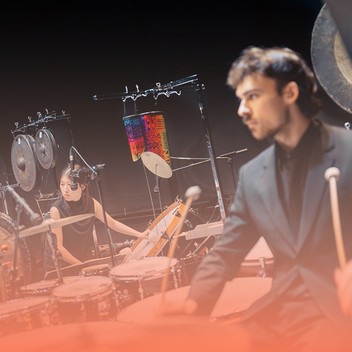Exhibition
Concert de clôture 2

Reading Time 4 mn
By Jérémie Szpirglas
The story takes place in a far far away future, thousands, even millions of years away… It has been ages now since humankind has left this valley of tears. Traces of its past existence however, are everywhere, scattered in the dust of our planet. Some archaeologist from the future – is it a team of alien explorers? An artificial intelligence sent from a faraway land? Or maybe a human-made machine that has just woken up from a very long sleep? – discovers amongst the ruins and remains of our succeeding civilizations several devices and objects that grab their attention. In the course of their research, this Indiana Jones from outer space realizes that these objects and devices work in pair: the objects carry data, while the devices are intended to read that data. But what is that data and what purpose does it serve? Why is there so much of it and why has it been duplicated identically millions of times?
Would this conscious being, so distant from us, be able to hypothesize that this data is actually code to reproduce a soundwave? Would they understand what sound – that is to say, the vibration of air – even is? And if they don’t, could they comprehend the concept of music, even if they are not receptive to it? Would they be able to differentiate sound data from other kinds of data? And finally, would they be able to apprehend the concept of form or, being deprived of any notion of threshold, would they consider that everything in on a continuum, or on the contrary, a discretized series of moments or gestures?
In order to justify their expedition to their investors, or simply to write down their observations and synthesize their thoughts, our researcher starts composing from its parts what they imagine could be the whole. By doing so, they create a big mashup made up of all of these sounds and non-sounds, a kind of “in the style of human beings” where all time periods, all ideas, everything that might have moved them in some way or another, – but also all the flaws resulting from the conditions the objects were found in: glitches, scratch marks, dust, distortions caused by the heat, the cold or by magnetic fields – are mixed together.
Photo: Composer Mauro Lanza © Andris Kozlovskis
For Mauro Lanza, the most technologically challenging aspect of his piece In the Dust of this Planet is to be able to put himself “in the shoes” of this future intelligence who he imagines to be using the same “learning” process as current learning machines – or at least to create the illusion. What results from this learning process naturally depends on the dataset it is based on (which can contain samples that have nothing to do with music, but also be influenced by different biases), as well as the set modalities (which vary according to the chosen parameters, such as the characteristics of sound he finds interesting, the level of granularity selected to analyze them, etc.). It is as if the composer himself became a sort of “black box”, in the same way the internal workings of the learning algorithms we use today still remain a mystery.
“I also used modular synthesizers that produce more or less chaotic sounds, as well as more traditional synthesis engines in the Csound application, oscillators, and sound and feedback generators.”
“All samples were analyzed automatically by the machine: I chose settings such as the noise level, the zero-crossing rate (which is the number of times the function representing the signal goes through 0), the spectral centroid (which is an average of the frequencies resulting from the spectral analysis of the sample), the degree of harmonicity, and the analysis of the main peaks… Then, I wrote an algorithm, using LISP language, that would dig around in my dataset for sounds matching certain criteria that seem relevant in terms of human sound perception depending on the part of the piece I was working on – while also defining a scope for deviation from the request. This step is conducted kind of blindly, in order to let the machine operate freely. The results I get are surprising every time. I then choose amongst them the samples I like the most.”
“Next step is analyzing the selected sample and its reproduction… And most importantly how it fits within the general form: what I find interesting is to see how sounds come together. Especially when dealing with chaotic sounds, that can completely transform into something else when a parameter on a synthesis module is even slightly modified…” As for the form, the idea is the same: to give the impression that operations are carried out by a non-human intelligence: “The structure is very rigid, set by unmovable rhymical workings. The form can be reminiscent of a slow deep-learning process: the beginning suggesting a process that is lacking in maturity, before the machine catches up and ends up learning too well, until it slips into excessive learning. Because when everything is considered the same by the machine, then nothing really matters anymore...”